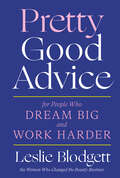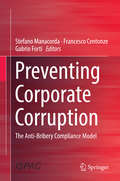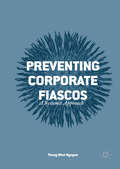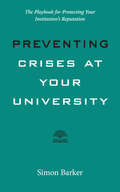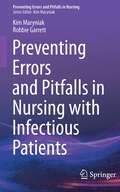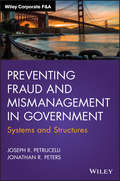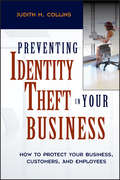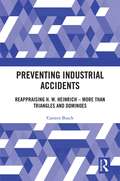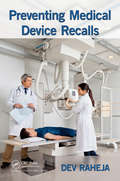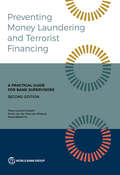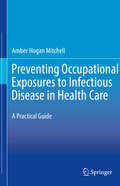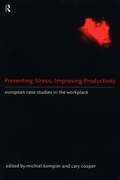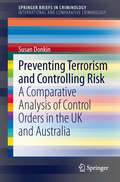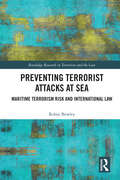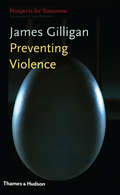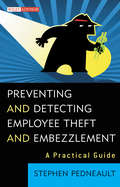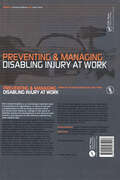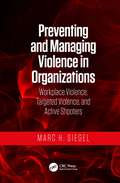- Table View
- List View
Pretty Good Advice: For People Who Dream Big and Work Harder
by Leslie Blodgett“[A] new literary genre, the MBA Memoir . . . Delivers 97 pearls of warmth, wit and wisdom from the most inspirational entrepreneur I have ever met.” —Frances Edmonds, bestselling author of Repotting Your Life Called the “Queen of Beauty” and the most influential lone woman to impact the beauty industry since Estée Lauder by the New York Times, Leslie Blodgett’s story is anything but ordinary. As the CEO of BareMinerals, she reinvented how beauty was sold by tapping into the power of community before the idea of social media existed. In 2006, Blodgett took the company public in one of the largest cosmetic IPOs of the decade, and in 2010, the company was acquired for $1.8 billion. Pretty Good Advice is her next chapter. This refreshing book features 97 candid and entertaining insights on business, life, and beauty. Personal and often surprising, Blodgett dishes on leading with humor, why wearing blush and reading obituaries are two of the most optimistic things you can do, and why you owe it to your coworkers not to be boring. Pretty Good Advice is full of frank, actionable advice to help light a fire under you.“If you want to laugh, get totally inspired, learn a bunch and enjoy reading something so engrossing you won’t put it down but you could because it’s written in these amazing one-ish-page chunks, GET IT. Could not be better for right now.” —Jean Godfrey June, Beauty Editor, GOOP“A moving and clear-eyed memoir of an extraordinary life. Charmingly made-up as a how-to guide, Leslie chronicles that life in vivid and memorable lessons that jump off the page.” —John W. Evans, author of Should I Still Wish
Pretty Powerful: Appearance, Substance, and Success
by Eboni K. WilliamsFOX News co-host and radio personality Eboni K. Williams believes that women shouldn’t hide their beauty. Instead, they should embrace it as a positive and powerful asset. Williams describes how her own career has been positively influenced by making strategic and intentional decisions about her appearance, what works best and when, all while staying true to her own personal style and values. Regardless of the decade, whether they were entering the workforce, seeking a leadership role, or looking to ascend to the C-suite, women (and even men) have always felt the professional need to embody a certain aesthetic appeal and individual personal power. Women, especially, have been sold the lie that being “pretty” comes at the expense of being taken seriously and that being “pretty” and being capable are mutually exclusive. In PRETTY POWERFUL, Eboni K. Williams encourages readers to reject the knee-jerk reaction to be shamed by this potential advantage and to stop leaving this incredibly powerful asset unused. In each chapter, Williams is joined by other powerful women like Meghan McCain, Marcia Clark, and Desiree Rogers and explores how many others have learned to balance their “prettiness” with substance—to both look the part and express their intelligence in a way that is authentic and respected. While opinions may have differed through time, one fact remains: a personal “pretty” brand is perhaps the most immediate and obvious tool in a woman’s professional arsenal.
Prevailing Worldviews of Western Society since 1500
by Glenn Richards MartinThis text is a concise study of the conflicting worldviews we face today. It is published from lectures and retains the author's engaging style. Dr. Martin analyzes the structures and procedures which inform government, law, economics, and international relations. He links these institutions to their underlying philosophical and theological roots.
Prevent Senior: A New Paradigm for Growth in the Health Care Sector?
by Regina E. Herzlinger Ana Maria Malik Priscilla ZogbiCase
Prevent Senior: A New Paradigm for Growth in the Health Care Sector?
by Regina E. Herzlinger Ana Maria Malik Priscilla ZogbiCase
Preventing Corporate Corruption
by Stefano Manacorda Francesco Centonze Gabrio FortiThis book presents the results of a two-year international research project conducted for the United Nations Office on Drugs and Crime (UNDOC) to investigate and provide solutions for reducing bribery and corruption in corporations and institutions. It starts with an empirical case study on the effectiveness of a set of self-regulation rules adopted by multinational companies in the energy sector. Second, it explores the context and factors leading to corruption internationally (and the relationships between domestic criminal law and self-regulation). Third, it examines guidelines for the adoption of compliance programs developed by international institutions, to serve as models for the future. The principle result of the book is a three-pronged Anti-Bribery Corruption Model (so called ABC Model), endorsed by the United Nations, intended as a corruption prevention tool intended to be adopted by private corporations. This work provides a common, research-based standard for anti-bribery compliance programs, with international applications. This work will be of interest to researchers studying Criminology and Criminal Justice, particularly in the areas of organized crime and corruption, as well as related areas like Business Ethics and Comparative International Law.
Preventing Corporate Fiascos
by Thang Nhut NguyenThe lasting effects of corporate fiascos on business and the economy have spurred investigations, panel discussions, and research in an attempt to find out why these events happen and ways to prevent them. Through case studies and analysis of bankruptcy and institutional collapse, Preventing Corporate Fiascos examines the root cause of these disasters and offers a management exceptions system that diagnoses potential failure from the start. Dr. Nguyen's unique framework is inspired by the biological spectrum, using cancer and disease as a metaphor for prevention and destruction. He uses a proven management repertory grid technique to evaluate aberrant and emotionally-charged decisions which could bring an institution to collapse. By recognizing the institution, its employees, the market and the economy as components of the biological spectrum, we can identify aggravating failure and disease and begin to take effective steps toward prevention.
Preventing Crises at Your University: The Playbook for Protecting Your Institution's Reputation (Higher Ed Leadership Essentials)
by Simon R. BarkerA new playbook for effective crisis management in higher education.Unlike other industries, in higher education an institution's most important asset is its reputation. Yet as fundamental as it is, many leaders continue to view managing reputation as dishonest and counterproductive, a suspect process that undermines the very idea of reputation as an organic outcome of reality. When leadership credibility is on the line, though, and an institution's reputation is facing potentially irreparable damage, the concept of reputational risk moves from being nebulous to all too tangible. In Preventing Crises at Your University, Simon Barker demonstrates how critical it is for colleges and universities to align strategy and values with decision-making during times of crisis. Arguing that leaders must stop considering the discussion of reputational risk as unseemly, he demonstrates that this discussion is in fact a strategic imperative for every leader. Significant reputational damage, Barker asserts, is not the inevitable outcome of a crisis but of a poor response. Defining a new crisis leadership playbook to deal with self-inflicted crises, he also• explains what typically goes wrong in a crisis;• describes how to prevent crises from escalating;• demonstrates how a stakeholder-centric model of communications can help mitigate reputational damage; and• introduces a number of original concepts, including a Reputational Risk Management Framework, a Reputational Risk Maturity Model, and a Culture and Capability matrix.Moving beyond the theoretical by presenting case studies of real crises involving sexual assault, freedom of speech, student protests, faculty misconduct, and a broad range of financial, social, and ethical issues, the book highlights and underscore key concepts around effective management of reputational risk. Ultimately, Preventing Crises at Your University serves as a wake-up call for all higher education leaders and board members.
Preventing Errors and Pitfalls in Nursing with Infectious Patients
by Kim Maryniak Robbie GarrettThis book informs nurses about the most common and the more serious errors made in caring for patients with infectious diseases. It provides learnings about a variety of infectious diseases, including COVID-19, methicillin-resistant Staphylococcus aureus (MRSA), Vancomycin-resistant Enterococcus (VRE), Clostridium difficile (C-diff.), and tuberculosis (TB), amongst others. Factors that are predisposing and contributing factors for nursing errors are reviewed. The types of errors, consequences, detection, and monitoring for nursing errors are included. This book examines how errors can be avoided with necessary precautions, and managed appropriately based on current evidence-based practice. Recommendations for further study are also provided. This book is a useful tool for nurse educators/ leaders/mentors to educate and guide their students and professional nurses.
Preventing Fraud and Mismanagement in Government: Systems and Structures
by Joseph Petrucelli Jonathan R. PetersDig to the root of public fraud with deep exploration of theory, standards, and norms Preventing Fraud and Mismanagement in Government identifies common themes in public fraud and corruption, describes the forces that drive them, and provides an objective standard of good practices with no political bent. From Bridgegate to Iran-Contra, this book walks through the massive scandals that resulted from public mismanagement and fraud to illustrate how deeply-entrenched, entity-specific norms can differ from actual best practices. The discussion includes the theoretical underpinnings of public fraud, and how intense corporate culture and limited exposure to outside practice standards can lead to routine deviation from normal behavior and moral standards. You'll find a compendium of practices that illustrate actual norms, allowing you to compare your own agency's culture and operations to standard practice, and contrast the motivations for fraud in the public and private sectors. Public agencies and governmental entities are generally driven by a pubic benefit or goal, but are widely varied in the ability and desire to deliver value while retaining best practices. This book explicitly explores the common patterns of agency practices and cultural norms, and describes how they can easily cross over into illegal acts. Understand why fraud exists in the public sector Discover how your agency's mindset diverges from the norm Review cases where agency practices diverged from best financial practices Learn good practices in an objective, nonpolitical context The government/public sector provides some of the most basic services that are critical to a functioning society. Lacking a profit motive, these agencies nonetheless show a pattern of fraud and borderline behavior that could be mitigated with the adoption of standards and best practices. Preventing Fraud and Mismanagement in Government shares a canon of knowledge related to public operations and fraud, providing deep insight into the causes, solutions, and prevention.
Preventing Identity Theft in Your Business: How to Protect Your Business, Customers, and Employees
by Judith M. CollinsPreventing Identity Theft in Your Business is a reliable guide to help protect companies, their customers, and their employees from the growing problem of identity theft. Real-life examples show managers and executives how to identify business, customer, and employee identity theft, how these crimes are committed, how best to prevent them, and overall, develop an honest company culture. It also covers how to manage this threat in business reorganizations such as mergers, acquisitions, globalization, and outsourcing. Judith M. Collins (East Lansing, MI) is Associate Professor of Industrial and Organizational Psychology at the School of Criminal Justice at Michigan State University. She is also the Director of the Michigan State University Identity Theft Partnership in Prevention.
Preventing Ideological Violence
by Basia Spalek P. Daniel Silk Mary O’raweThis book presents the voices of police and community members who have been involved in engagement and partnership projects designed for countering violent extremism. Though the threat of the so-called Islamic State garners a great deal of current attention, the book explores ideological violence prevention efforts in a number of contexts, to include that of paramilitary organizations as well as Qa'ida inspired actors.
Preventing Industrial Accidents: Reappraising H. W. Heinrich – More than Triangles and Dominoes
by Carsten BuschHerbert William Heinrich has been one of the most influential safety pioneers. His work from the 1930s/1940s affects much of what is done in safety today – for better and worse. Heinrich’s work is debated and heavily critiqued by some, while others defend it with zeal. Interestingly, few people who discuss the ideas have ever read his work or looked into its backgrounds; most do so based on hearsay, secondary sources, or mere opinion. One reason for this is that Heinrich’s work has been out of print for decades: it is notoriously hard to find, and quality biographical information is hard to get. Based on some serious "safety archaeology," which provided access to many of Heinrich’s original papers, books, and rather rich biographical information, this book aims to fill this gap. It deals with the life and work of Heinrich, the context he worked in, and his influences and legacy. The book defines the main themes in Heinrich’s work and discusses them, paying attention to their origins, the developments that came from them, interpretations and attributions, and the critiques that they may have attracted over the years. This includes such well-known ideas and metaphor as the accident triangle, the accident sequence (dominoes), the hidden cost of accidents, the human element, and management responsibility. This book is the first to deal with the work and legacy of Heinrich as a whole, based on a unique richness of material and approaching the matter from several (new) angles. It also reflects on Heinrich’s relevance for today’s safety science and practice.
Preventing Medical Device Recalls
by Dev RahejaA critical and often overlooked aspect of preventing medical device recalls is the ability to implement systems thinking. Although systems thinking won‘t prevent every mistake, it remains one of the most effective tools for evaluating hidden risks and discovering robust solutions for eliminating those risks.Based on the author‘s extensive experienc
Preventing Money Laundering and Terrorist Financing, Second Edition: A Practical Guide for Bank Supervisors
by Pierre-Laurent Chatain Emile van der Does de Willebois Maud BökkerinkMoney laundering and terrorist financing undermine the integrity and stability of financial systems and can have a significantly adverse impact on a jurisdiction's economy. Challenges to effective supervision and prevention of money laundering and financing of terrorism were exacerbated in the aftermath of the 2008 financial crisis, with financial institutions' need for funds at times undermining vigilance as to the provenance of those funds. As such, supervisors often, and prudently, focused on coping with the crisis. Since 2009, when the first edition of this handbook was published, challenges to the integrity and stability of financial systems have continued to evolve. Money-laundering and terrorist-financing risks continue to threaten the reputations of financial institutions and entire financial sectors, exposing institutions to the possibility of severe enforcement action by public authorities or the loss of correspondent relationship facilities by their private sector counterparts. This second edition reflects the evolving challenges to the integrity and stability of financial systems, recent trends in enforcement actions by country authorities, and changes to international standards, notably an emphasis on a risk-based approach. This practical handbook supports the implementation of international standards established by the Financial Action Task Force and other bodies, * Providing examples of money-laundering and terrorist-financing supervisory frameworks in a range of countries; * Describing best practices for the supervision and enforcement of money-laundering and terrorist-financing laws and regulations; * Offering practical advice on how a particular jurisdiction might incorporate enforcement of the laws and regulations on money laundering and terrorist financing into its supervisory framework. Designed specifically for bank supervisors, this guide will also be of interest to readers working in the areas of finance, corruption prevention, law, accounting, and corporate governance.
Preventing Occupational Exposures to Infectious Disease in Health Care: A Practical Guide
by Amber Hogan MitchellThis book is a practical guide for preventing occupational exposures to bloodborne and infectious disease in health care. It is a timely and essential resource given that people working in healthcare settings sustain a higher incidence of occupational illness than any other industry sector, and at the time of publication of this book we are in the midst of a global pandemic of COVID-19. While the guide is focused on health care primarily, it would be useful for preventing exposures to essential workers in many other industries as well.The guide offers easy-to-follow instruction, all in one place, for creating, implementing, and evaluating occupational health and safety programs. Readers have practical information that they can use now to either build a new program or expand an existing one that protects workers from occupationally associated illness and infection. With a focus on the public health significance of building better, safer programs in health care, the book provides not just the evidence-based or data-driven reasoning behind building successful programs, but also includes sample programs, plans, checklists, campaigns, and record-keeping and surveillance tools. Topics explored among the chapters include: • Occupational Safety and Health Administration (OSHA) Regulatory Compliance • Other Regulatory Requirements, National Standards, and Accreditation • Performing a Hazard Assessment and Building an Exposure Control Plan • Engineering Controls and Safer Medical Devices • Personal Protective Equipment Placement and Use • Facing a Modern PandemicPreventing Occupational Exposures to Infectious Disease in Health Care is a comprehensive resource for both seasoned and novice professionals with primary, secondary, or ancillary responsibility for occupational or employee health and safety, infection prevention, risk management, or environmental health and safety in a variety of healthcare or patient care settings. It also would appeal to those working in public health, nursing, medical, or clinical technical trades with an interest in infection prevention and control and/or occupational health and infectious disease.
Preventing Regulatory Capture
by David A. Moss Daniel CarpenterWhen regulations (or lack thereof) seem to detract from the common good, critics often point to regulatory capture as a culprit. In some academic and policy circles it seems to have assumed the status of an immutable law. Yet for all the ink spilled describing and decrying capture, the concept remains difficult to nail down in practice. Is capture truly as powerful and unpreventable as the informed consensus seems to suggest? This edited volume brings together seventeen scholars from across the social sciences to address this question. Their work shows that capture is often misdiagnosed and may in fact be preventable and manageable. Focusing on the goal of prevention, the volume advances a more rigorous and empirical standard for diagnosing and measuring capture, paving the way for new lines of academic inquiry and more precise and nuanced reform.
Preventing Stress, Improving Productivity: European Case-Studies in the Workplace
by Cary Cooper Michiel KompierIn a representative study made of European workers, twenty-eight per cent of employees reported that stress affects their health and their performance at work. Occupational stress is a serious problem for the performance of individuals, organisations and as a consequence, for national economies. Preventing Stress, Improving Productivity investigates the ways in which companies can combat stress by changing the working environment rather than only treating individual employees with stress symptoms.Costs and benefits of stress prevention are discussed, with an emphasis on appraoches that involve both the work situation and the individual worker. The heart of the book consists of eleven European country chapters, each overviewing the current status with respect to occupational stress and its prevention in that country and then presenting one detailed case study an example of good preventive practice. Preventing Stress, Improving Productivity identifies five factors that are critical for a stress reduction programme to work, both in terms of employee health and well-being and from a financial point of view. Successful strategies combine participation from workers and support from top management. Useful as a reference for psychologists, human resource managers, occupational physicians, ergonomists and consultants, this book will also be an invaluable aid to managers in the day-to-day running of organisations.
Preventing Terrorism and Controlling Risk
by Susan DonkinThis Brief takes a provocative look at existing socio-legal literature with a comparative study of terrorism control orders, focusing on how the concept of pre-emption fits within a traditional criminological framework. This timely work examines how such measures might be conceived and interpreted within a situational crime prevention approach. Over the past decade, socio-legal scholars have identified a rise in pre-emptive control mechanisms to respond to terrorism and other threats in the post-9/11 world. Many have argued that this pre-emptive rationale has been used to justify the introduction of measures that transcend established legal and risk frameworks, to deal with individuals or groups thought to pose a threat to the state or its citizens. Preventing Terrorism and Controlling Risk: A Comparative Analysis of Control Orders in the UK and Australia will be of interest to researchers in Criminology and Criminal Justice, particularly with a focus on terrorism, risk assessment, and human rights.
Preventing Terrorist Attacks at Sea: Maritime Terrorism Risk and International Law (Routledge Research in Terrorism and the Law)
by Robin BowleyOver recent decades, it has been widely recognised that terrorist attacks at sea could result in major casualties and cause significant disruptions to the free flow of international shipping. After discussing the overlaps and distinctions between piracy and maritime terrorism, this book considers how the International Ship and Port Facility Security Code, and other vessel identification and tracking measures in the 1974 International Convention for the Safety of Life at Sea, would be likely to reduce the risk of terrorist attacks at sea. It explains how the 1982 United Nations Convention on the Law of the Sea is less than clear on the powers of states to protect offshore installations, submarine cables and pipelines from interference by terrorists. In light of these uncertainties, it considers how the 2005 Protocol to the Convention for the Suppression of Unlawful Acts Against Maritime Navigation, the doctrine of necessity and states’ inherent self-defence rights might apply in the maritime security context. A significant contribution of the book is the formulation of the Maritime Terrorism Threat Matrix, which provides a structured framework for examining how maritime terrorism incidents have occurred, and might occur in the future. The book also examines the relevant national maritime security legislation for preventing maritime terrorist attacks in the United Kingdom and in Australia. The book concludes by formulating guidelines for the unilateral interdiction of suspected terrorist vessels in exceptional circumstances, and recommending priorities for governments and international maritime industries to focus on in order to reduce the risk for terrorist attacks at sea. It will be of interest to those working in the areas of Law and Terrorism, Law of the Sea, Maritime Law and Insurance and International Law.
Preventing Violence (Prospects for Tomorrow)
by James GilliganIn this controversial and compassionate book, the distinguished psychiatrist James Gilligan proposes a radically new way of thinking about violence and how to prevent it. Violence is most often addressed in moral and legal terms: "How evil is this action, and how much punishment does it deserve?" Unfortunately, this way of thinking, the basis for our legal and political institutions, does nothing to shed light on the causes of violence. Violent criminals have been Gilligan's teachers, and he has been their student. Prisons are microcosms of the societies in which they exist, and by examining them in detail, we can learn about society as a whole. Gilligan suggests treating violence as a public health problem. He advocates initiating radical social and economic change to attack the root causes of violence, focusing on those at increased risk of becoming violent, and dealing with those who are already violent as if they were in quarantine rather than in constraint for their punishment and for society's revenge. The twentieth century was steeped in violence. If we attempt to understand the violence of individuals, we may come to prevent the collective violence that threatens our future far more than all the individual crimes put together.
Preventing War: The United Nations and Macedonia
by Abiodun WilliamsDescribes the role the UN played in Macedonia.
Preventing and Detecting Employee Theft and Embezzlement
by Stephen Pedneault"If you don't think that some employees have figured out ingenious ways to steal from businesses, read this book. The real-life examples will change your mind. " -Joseph T. Wells, CFE, CPA, founder and Chairman, Association of Certified Fraud Examiners "An easy-to-read, but comprehensive step-by-step approach that covers every potential area for employee fraud and embezzlement. Great checklists at the end of each chapter show what steps to put into place for controls and protection. Includes real-life examples that really 'bring the story home. ' " -Jean L. Conover, CPA, past CEO/CFO, Jefferson Radiology PC "This book is a must-read for seasoned entrepreneurs as well as those considering entering their own business venture. While developed for small business, the risk detection and prevention methodologies presented by Mr. Pedneault are universal to all businesses. The concise checklists provide ready guidance for establishing a complete system of controls. "-Denise H. Armstrong, CPA, Chief Financial Officer, Sea Research Foundation, Inc. d/b/a Mystic Aquarium and Institute for Exploration "This book is a must for every individual owning their own business. Mr. Pedneault clearly articulates the fraud risks that occur in each business system. In the book, he offers practical advice for internal controls and illustrates the risks with real-life examples. "-Leonard W. Vona, President, Fraud Auditing, Inc.
Preventing and Managing Disabling Injury at Work
by John Frank Terrence SullivanThis unique reference reveals what works best in preventing workplace disability. Preventing and Managing Disabling Injury at Work examines the changing nature of the workplace and work force and includes recent information on effective early and staged multi-modal interventions in the workplace. The text also explores psychological risk perception and the essential linking of the workplace, clinician, insurer, and worker in the recovery process and in the prevention of subsequent disability events. Well-illustrated with case studies and practical examples, much of the book focuses on the common musculoskeletal disabilities and regional disorders along with other, broader applications.
Preventing and Managing Violence in Organizations: Workplace Violence, Targeted Violence, and Active Shooters
by Marc H. SiegelOrganizations of all types and sizes, whether they are a business, educational institution, healthcare provider, or house-of-worship, need to plan for the possibility of violent acts that may impact its people, assets, and activities. Preventing and Managing Violence in Organizations: Workplace Violence, Targeted Violence, and Active Shooters provides a comprehensive approach to addressing workplace violence, active shooter and assailant events, and other forms of targeted violence. The book takes a unique perspective that the prevention and management of violence in an organization is a risk and business management issue, rather than a siloed security issue. As such, the book’s objective is to help organizations develop a program for preventing and managing violence that can be integrated into their day-to-day overall business management approach. The main theme of the book is that any program to prevent and manage violence in an organization needs to be an inclusive process: where everyone in the organization is viewed as a risk maker and risk taker, and therefore, a risk manager. The emphasis is on building a risk and security awareness culture in the organization so that everyone throughout the organization is aware and part of the solution. The book recognizes that many, if not most, organizations do not have a dedicated chief security officer to oversee the prevention and management of violence. It also recognizes that many resource allocation decisions are made by business managers, not the security manager. While other books approach this issue from a security perspective, this book takes the perspective that providing a safe and secure environment within the organization, and protecting its people, assets, and activities, is a business management imperative. Therefore, the book emphasizes the need to promote a risk and security awareness culture that is integrated into the organization's system of management and all its activities and functions. The "Introduction" section of the book includes a brief description of violence in organizations and the imperative for integrating the prevention and management of violence into the organization’s overall business management strategy. The "Framework" section helps business, human resource, risk, security, and safety managers build a programmatic framework to support prevention and management of violence in all the organizations activities. The "Tactics and Control Measures" section provides tactical and operational advice and tools on methods to prevent, respond to, and recover from potentially violent events. For organizations that have adopted an ISO, Robust Process Improvement, or Six-Sigma management systems approach, they will immediately recognize that the elements described in the framework can be integrated seamlessly into their overall management system approach. Preventing and Managing Violence in Organizations illustrates a systems approach for preventing and managing violence in organizations that can also be used for managing other types of operational risks. Security managers will find the book useful for integrating security in the organization’s day-to-day activities—as an integral part of these activities—rather than an add-on activity. Security professionals will be able to present their program from a business and risk management perspective.
